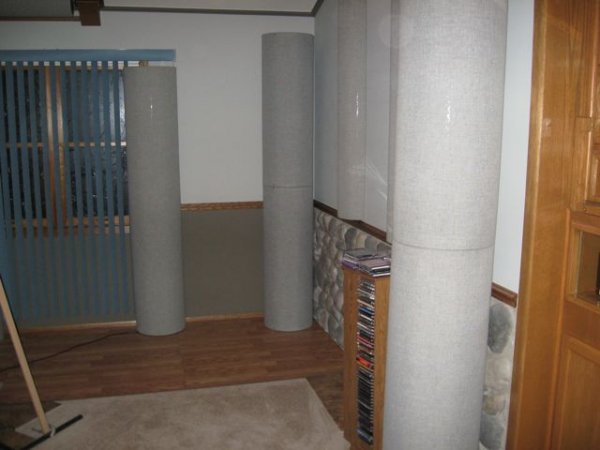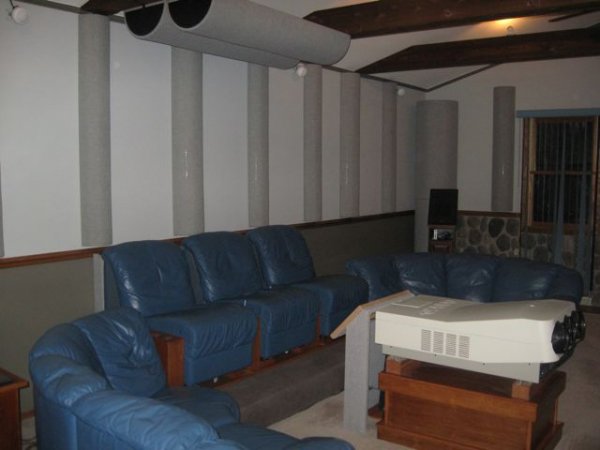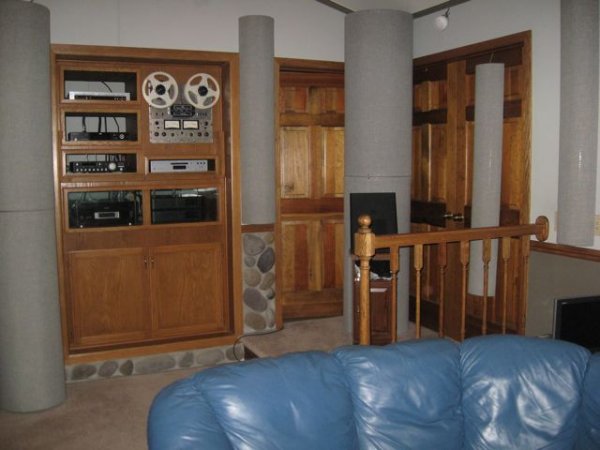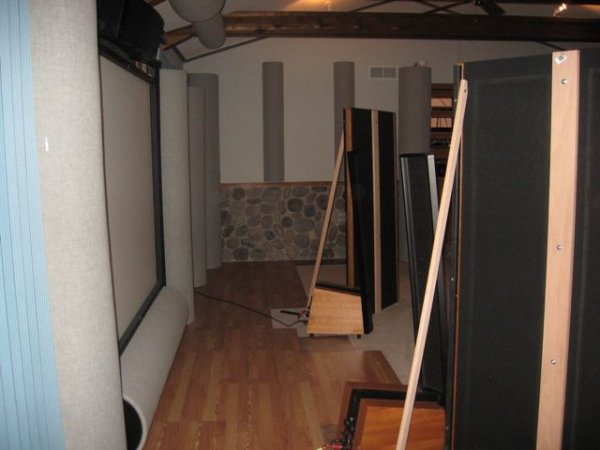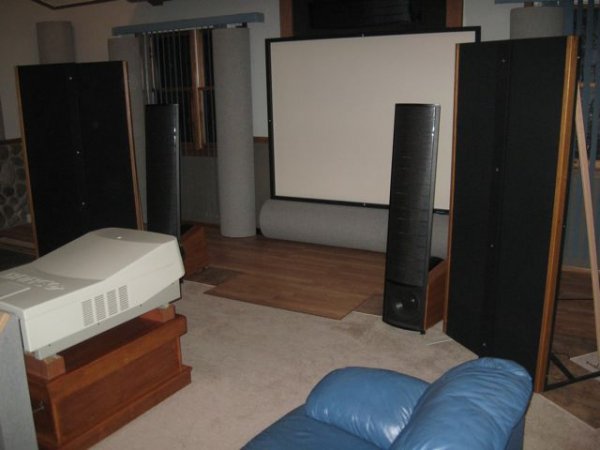Art, could you share any general thoughts, concepts, ideas, you have regarding planer/dipole speakers. In regards to room acoustics and getting the best sound at the sweet spot, thanks.
Planer/Dipole speakers: FAQ
- Thread starter TitaniumTroy
- Start date
You are using an out of date browser. It may not display this or other websites correctly.
You should upgrade or use an alternative browser.
You should upgrade or use an alternative browser.
One thing that I have learned and I'm sure that Art will chime in, is that the back wall is almost as important as the rest of the acoustics. In our room, the back wall is one big bass trap, very absorptive. Dipole/Bi-polar speakers will not work in at situation.
One thing that I have learned and I'm sure that Art will chime in, is that the back wall is almost as important as the rest of the acoustics. In our room, the back wall is one big bass trap, very absorptive. Dipole/Bi-polar speakers will not work in at situation.
Bruce,
Can you electorate why?
Bruce,
Can you electorate why?
If you have biplole speakers that rely on rear facing speakers to enhance ambience (or whatever), an absorptive surface will kill all the frequencies. Same with dipole speakers that rely on some sort of diffusive or reflective surface behind the speaker to exacerbate the back wave. I've had Maggies for years and when I put Bipole or Dipole speakers in front of heavy drapery or this wall that is a big bass trap, then it makes the speakers sound dead and dry. No life at all.
Bruce, in re: Martin Logan planar dipoles, at least, Ethan has consistently advised owners to fully absorb the backwave, and many owners have followed that advice with excellent results. His assertion is that all of the information from the recording is contained within the front wave and that the back wave serves only to "confuse" the intended soundfield. Essentially, the unabsorbed backwave adds a form of artificial ambience while, as a result of comb filtering, reducing image clarity.If you have biplole speakers that rely on rear facing speakers to enhance ambience (or whatever), an absorptive surface will kill all the frequencies. Same with dipole speakers that rely on some sort of diffusive or reflective surface behind the speaker to exacerbate the back wave. I've had Maggies for years and when I put Bipole or Dipole speakers in front of heavy drapery or this wall that is a big bass trap, then it makes the speakers sound dead and dry. No life at all.
Art used to manufacture a "Back Box" for the ML Aerius, specifically designed to absorb the backwave. Similarly, Soundlab used to sell a "Sallie" absorber to be placed directly behind the speaker. Even Gayle Sanders ultimately had an eye-opener as regards back wave absorption. I suspect that, in the end, it's simply a personal preference: Additional ambience vs. pin-point imaging or, by careful choice of room treatment, somewhere in between.
It'll be interesting to see if Art has a different take than Ethan. IIRC, Art owns or owned Martin Logans.
I agree with RUR - with dipole loudspeakers, you do not always want a "live" front (Bruce called it rear) wall (the wall behind the loudspeakers in front of the listener). You do not always have to FULLY absorb the backwave. The objective of a dipole loudspeaker is side cancellation, NOT front wall reflection for "ambience". I think that confuses the soundstage and imaging if done wrong.
While the front wall should not be totally "dead", it should not be totally reflective either. That is where set-up and room treatment can optimize both pin-point imaging and ambience with dipole loudspeakers.
While the front wall should not be totally "dead", it should not be totally reflective either. That is where set-up and room treatment can optimize both pin-point imaging and ambience with dipole loudspeakers.
I have had dipoles (Maggies and 'stats) in many rooms and flavors of treatment through the years. My current room is heavily damped behind the (Magnepan MG-IIIa) speakers for various reasons. I do not mind a "dry" sound, however, perhaps due to some work in studios where the mastering room was pretty dead. I appreciate the fact that any ambience I hear is from the source and not the room, and the reduction in comb filter and other effects so I end up with pin-point imaging and a very stable sound stage.
I do agree, however, that a somewhat live room sounds more impressive even if it is a much bigger PITA to set up and knowing it is corrupting the source a bit. Personally, had a bit bigger room and budget, I would have used a mix of diffusion and absorption as that seems to me to provide a good balance among FR, imaging, and that old "in-the-head-sound" we all like.
I am very curious to see the expert answer to this; my experience has been one of varying between getting the sound technically best and sounding best despite technical flaws, the endless debate. - Don
I do agree, however, that a somewhat live room sounds more impressive even if it is a much bigger PITA to set up and knowing it is corrupting the source a bit. Personally, had a bit bigger room and budget, I would have used a mix of diffusion and absorption as that seems to me to provide a good balance among FR, imaging, and that old "in-the-head-sound" we all like.
I am very curious to see the expert answer to this; my experience has been one of varying between getting the sound technically best and sounding best despite technical flaws, the endless debate. - Don
A couple of things to worry about with dipoles and the front wall:
A) speaker boundary interference. Since dipoles project very strongly to the rear you almost always get a deep suckout at the listening position from interference of direct and indirect sound waves.
B) strong early reflection from a location that is not very useful for creating any additional feelings of envelopment. Has the effect of reducing clarity and smearing imaging.
Both A and B can be reduced by increasing the distance from the front wall. Since the SPL reduces at an inverse square of distance from the source you can use distance to reduce the negative effect of A and B. On B) Jeff Hedback and I are agreeing that a 15dB reduction in SPL of reflections is the target for high end audio, which makes the path length difference requirement 15ft. For most people having speakers 7ft or so (15ft/2) from the back wall is not practical so we must look to use some form of reflection redirection, diffusion or absorption.
There is also the discussion point of what the target should be for late reflected sound and how dipoles are different from other speakers in this regard. Jeff and I have agreed that late reflected sound should be 15dB down, spectrally consistent and not have any individual reflections 6dB above the average.
A) speaker boundary interference. Since dipoles project very strongly to the rear you almost always get a deep suckout at the listening position from interference of direct and indirect sound waves.
B) strong early reflection from a location that is not very useful for creating any additional feelings of envelopment. Has the effect of reducing clarity and smearing imaging.
Both A and B can be reduced by increasing the distance from the front wall. Since the SPL reduces at an inverse square of distance from the source you can use distance to reduce the negative effect of A and B. On B) Jeff Hedback and I are agreeing that a 15dB reduction in SPL of reflections is the target for high end audio, which makes the path length difference requirement 15ft. For most people having speakers 7ft or so (15ft/2) from the back wall is not practical so we must look to use some form of reflection redirection, diffusion or absorption.
There is also the discussion point of what the target should be for late reflected sound and how dipoles are different from other speakers in this regard. Jeff and I have agreed that late reflected sound should be 15dB down, spectrally consistent and not have any individual reflections 6dB above the average.
I own Soundlabs and have owned Quad ESL63 and Martin Logan Prodigy. After many experiences with sound treatment I agree with Bruce - if you completely absorb the backwave of dipoles you make them sound boring and lifeless. The sound treatment of my room front wall is build using upper and lower edge bass traps, 6 feet tall RPG diffractals diffusers and abffusors . This last type of panels really absorb almost 100% - if you build a small square chamber with them and put your head inside it seems you are in anechoic chamber. I have some extra panels of both types so I could try different settings. For dipolar panels I use absorption only near the corner edges and diffractals in the middle. However for most box speakers I prefer to have the diffractals in the outer positions and many abffusors in the middle area.
On the sidewall I only use some flutter free diffusing structures.
During some time I made a lot of experiments with sound absorbers built using 2" thick rigid fiber glass at the reflection points, but this is not my type of sound. Others will surely think differently.
Although it degrades the performance a little I hide the whole set of treatments behind a black curtain - the large speaker clothes are black and they blend in the back wall using moderate illumination.
On the sidewall I only use some flutter free diffusing structures.
During some time I made a lot of experiments with sound absorbers built using 2" thick rigid fiber glass at the reflection points, but this is not my type of sound. Others will surely think differently.
Although it degrades the performance a little I hide the whole set of treatments behind a black curtain - the large speaker clothes are black and they blend in the back wall using moderate illumination.
@Nyal -- Ooh, numbers, cool, thank you!
@microstrip -- I don't think I've ever heard them described as "boring and lifeless" but point taken. My current situation is using much more absorption than I have used in the past. I would like to add more diffusion later, but other things are holding back that effort for now.
@microstrip -- I don't think I've ever heard them described as "boring and lifeless" but point taken. My current situation is using much more absorption than I have used in the past. I would like to add more diffusion later, but other things are holding back that effort for now.
Aye, there's the rub.....spectrally consistent and not have any individual reflections 6dB above the average.
Thanks for the preview, Nyal.
All the Maggies I've owned have been at least 4' out into the room with reflective/diffusive hard surfaces behind them. I felt they sounded the best this way. I see them in shows and they are in front of light curtains with solid wall or glass behind that.
Magnepan suggests 5' min, and in a bigger room I would have them out and away and use far less absorption, at least full-range. As it is, mine are fairly close to the walls (maybe only 2' or so on the side, and perhaps 3' behind) thus the extra absorption. When I last had them set up it ws in a bigger room and I used far fewer panels behind. I had to give up room volume (and my prime dimensions) for an extra bedroom and associated hallway in the basement. The basement bedroom made my son very happy and probably adds more to the resale value, but I still wish I had my original dimensions!
I used to run my full-range Apogee panels about 7 feet from the front wall. I used towers of ASC tube traps in the corners behind them, another tower in the middle behind them, and towers at the first sidewall points (possibly unnecessary).
Lee
Lee
IME, the back wave (roughly equal in amplitude to the front wave upon launch) makes dipoles (much) harder to set up and more sensitive to room and placement than other types of speakers. I prefer their sound and (generally) low distortion, though they are (again generally) more limited in maximum output SPL (not a problem since they are loud enough for me).
There are pix of my room and a PDF (in a post near the end of the thread) of my room here. I have since moved the couch a little forward to get a bit further out of a room mode null, and the XPA-3 has been replaced by an XPA-5 so the SC-27 is used as a pre/pro. I was planning to add a few more panels, mainly to reduce that durn null, but have not been inclined to do so for various reasons. The rear panels are primarily for bass absorption; the media shelves provide a bit of reflection/diffusion on the back wall. Feel free to use it to critique the setting up of dipoles.
FWIWFM - Don
p.s. I used RT+D software on an old notebook, with an outboard Creatieve sound card and inexpensive m-audio preamp behind an Earthworks measurement mic to tweak the FR. It is not all that flat, but good enough for me, about +/- 6 dB from 10 Hz to 20 kHz with unsmoothed, 1/12th-octave sweep. Sorry about the pix size; I did not have small versions of these (maybe later). This was from last August; I have moved a few things slightly since then but have not measured and tweaked the response since.
Raw room:
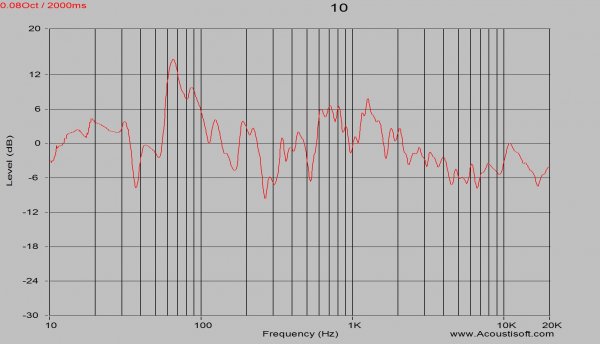
After MCACC:
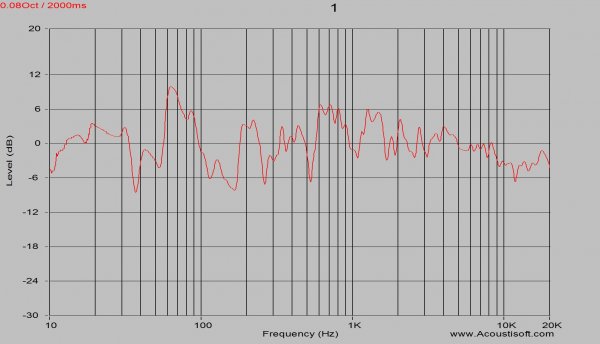
After tweaking the MCACC settings (I'm an engineer, tweaking is what I do! ):
):
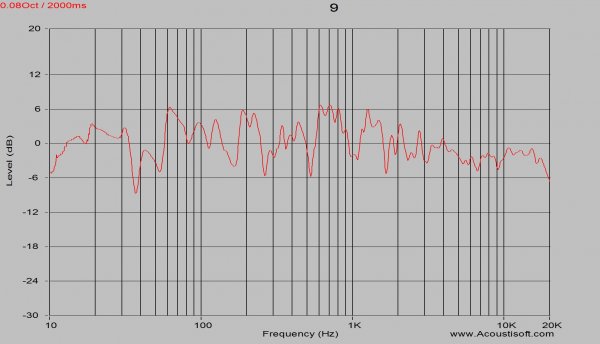
There are pix of my room and a PDF (in a post near the end of the thread) of my room here. I have since moved the couch a little forward to get a bit further out of a room mode null, and the XPA-3 has been replaced by an XPA-5 so the SC-27 is used as a pre/pro. I was planning to add a few more panels, mainly to reduce that durn null, but have not been inclined to do so for various reasons. The rear panels are primarily for bass absorption; the media shelves provide a bit of reflection/diffusion on the back wall. Feel free to use it to critique the setting up of dipoles.
FWIWFM - Don
p.s. I used RT+D software on an old notebook, with an outboard Creatieve sound card and inexpensive m-audio preamp behind an Earthworks measurement mic to tweak the FR. It is not all that flat, but good enough for me, about +/- 6 dB from 10 Hz to 20 kHz with unsmoothed, 1/12th-octave sweep. Sorry about the pix size; I did not have small versions of these (maybe later). This was from last August; I have moved a few things slightly since then but have not measured and tweaked the response since.
Raw room:

After MCACC:

After tweaking the MCACC settings (I'm an engineer, tweaking is what I do!

Last edited:
ASC Tube traps with dipole speakers
I have Martin Logan Summits along side of Magneplanar Tympani IV bass panels.
ASC tube traps are placed behind these dipole speakers and above on the wall.
The speakers are placed from 6' to 10' from this wall and this large distance
to the wall behind the speakers reduces comb effects considerably. In my
experience with dipole speakers, eliminating the rear wave completely is a big
mistake as it takes all the life out of the sound. I also have hardwood flooring
behind the speakers, as this, in addition to the (great distance) provides a great
feeling of space and the imaging and soundstage is fantastic. The room is
completely treated with 35 ASC tube traps as well as GIK bass traps and other
diffusing devices. Placing ASC mid range tube traps 3' apart around the entire
perimeter of the room provides fantastic imaging and gives one the feeling of
great space. Voice reproduction is very real and easy to understand. Large
bass traps are in all corners from floor to ceiling as well as the midpoints of the
walls. Above the listening area are Large bass traps that also prevents comb
effects. Because of the even spacing of traps, one can walk around the room
and the sound is very uniform and realistic. This room is somewhat similar
to Peter Moncrieffs room of International audio review, which is on ASC's
website.
I have Martin Logan Summits along side of Magneplanar Tympani IV bass panels.
ASC tube traps are placed behind these dipole speakers and above on the wall.
The speakers are placed from 6' to 10' from this wall and this large distance
to the wall behind the speakers reduces comb effects considerably. In my
experience with dipole speakers, eliminating the rear wave completely is a big
mistake as it takes all the life out of the sound. I also have hardwood flooring
behind the speakers, as this, in addition to the (great distance) provides a great
feeling of space and the imaging and soundstage is fantastic. The room is
completely treated with 35 ASC tube traps as well as GIK bass traps and other
diffusing devices. Placing ASC mid range tube traps 3' apart around the entire
perimeter of the room provides fantastic imaging and gives one the feeling of
great space. Voice reproduction is very real and easy to understand. Large
bass traps are in all corners from floor to ceiling as well as the midpoints of the
walls. Above the listening area are Large bass traps that also prevents comb
effects. Because of the even spacing of traps, one can walk around the room
and the sound is very uniform and realistic. This room is somewhat similar
to Peter Moncrieffs room of International audio review, which is on ASC's
website.
Attachments
This is only true for point sources. Line sources exhibit an inverse linear attenuation law and infinite plane sources exhibit no attenuation whatsoever. A planar dipole can obey any of these laws, depending on its dimensions and on listening distance. Then there is the issue of beaming, which involves all of the above plus emitted wavelength.the SPL reduces at an inverse square of distance from the source
This is only true for point sources. Line sources exhibit an inverse linear attenuation law and infinite plane sources exhibit no attenuation whatsoever. A planar dipole can obey any of these laws, depending on its dimensions and on listening distance. Then there is the issue of beaming, which involves all of the above plus emitted wavelength.
This is true and a good point. However if a dipole is tall enough to be an acoustic line source then the reflection from the back wall will be stronger and hence more in need of acoustic treatment, since the dB loss will be less than for a point source.
Similar threads
- Replies
- 2
- Views
- 198
- Replies
- 7
- Views
- 2K
- Replies
- 1
- Views
- 2K
| Steve Williams Site Founder | Site Owner | Administrator | Ron Resnick Site Owner | Administrator | Julian (The Fixer) Website Build | Marketing Managersing |


